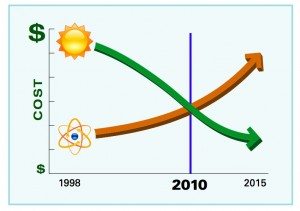 By: Molly Rovero LuxEco Editorial Assistant
By: Molly Rovero LuxEco Editorial Assistant
A recent report created for North Carolina’s Waste Awareness & Reduction Network (NC WARN) was titled “ Solar and Nuclear Costs- The Historic Crossover Solar Energy is Now the Better Buy”. Research for the report was conducted by two researches from Duke University, John O. Blackburn and Sam Cunningham. This year marks the switch when solar energy has now become cheaper than nuclear. Although energy from photovoltaics, or PVs, has always been viewed as a pricey alternative, the cost has dropped steadily over the years. This trend is predicted to continue along the same path in the future, whereas new nuclear power plants are becoming more and more expensive.
 For years environmentalists and members of the green movement have been pushing for more sources of renewable energy and it seems this year their dreams are finally coming true. Government officials never rejected the benefits of solar and other energy, but the cost has always been the enemy. Economic concerns are always front and center when new initiatives and improvements come around. North Carolina legislature stated that electrical development was to follow the path, which would cost the least. A combination of energy efficiency, wind power, solar hot water, combined heat and power, and now solar photovoltaics beat the cost of nuclear power. This pack of renewable energy sources together would provide the energy required, causing no need for other power sources.
For years environmentalists and members of the green movement have been pushing for more sources of renewable energy and it seems this year their dreams are finally coming true. Government officials never rejected the benefits of solar and other energy, but the cost has always been the enemy. Economic concerns are always front and center when new initiatives and improvements come around. North Carolina legislature stated that electrical development was to follow the path, which would cost the least. A combination of energy efficiency, wind power, solar hot water, combined heat and power, and now solar photovoltaics beat the cost of nuclear power. This pack of renewable energy sources together would provide the energy required, causing no need for other power sources.
 A comparison of price per kilowatt-hour between solar PVs and nuclear power shows the PVs as 2 cents cheaper. On a large scale this makes a huge difference and the gap in price will continue to grow as the cost of solar energy continues to decline. Tax benefits were previously part of the appeal for solar power, but the report also states “trend of cost decline in solar technology has been so great that solar electricity is fully expected to be cost-competitive without subsidies within the decade.”
A comparison of price per kilowatt-hour between solar PVs and nuclear power shows the PVs as 2 cents cheaper. On a large scale this makes a huge difference and the gap in price will continue to grow as the cost of solar energy continues to decline. Tax benefits were previously part of the appeal for solar power, but the report also states “trend of cost decline in solar technology has been so great that solar electricity is fully expected to be cost-competitive without subsidies within the decade.”
Osha Davidson of The Energy Collective hits on two points that the study missed, which make an even stronger case for solar energy. “North Carolina is not a “sun-rich” state” meaning they lack an abundance of sun year round. This could be a game changer for sunnier states like Arizona, California, Colorado, New Mexico, Texas, Nevada and Utah. Davidson’s second point is that photovoltaics were the only source of solar energy addressed in the study and it excluded Concentrated Solar Power, which is said to continue to work at least 6 hours after sunset.
It is a mystery why there are subsidies and supporters of nuclear energy when it creates radioactive waste, causing other such as finding places to store it for thousands of years, and it presents the lurking threat of another Chernobyl. Even with the argument of being more reliable, benefits of solar energy have always outweighed those of nuclear energy. The future of energy has arrived in the form of solar photovoltaics. Who can argue with a cleaner, safer, renewable source when it is now more cost efficient?













